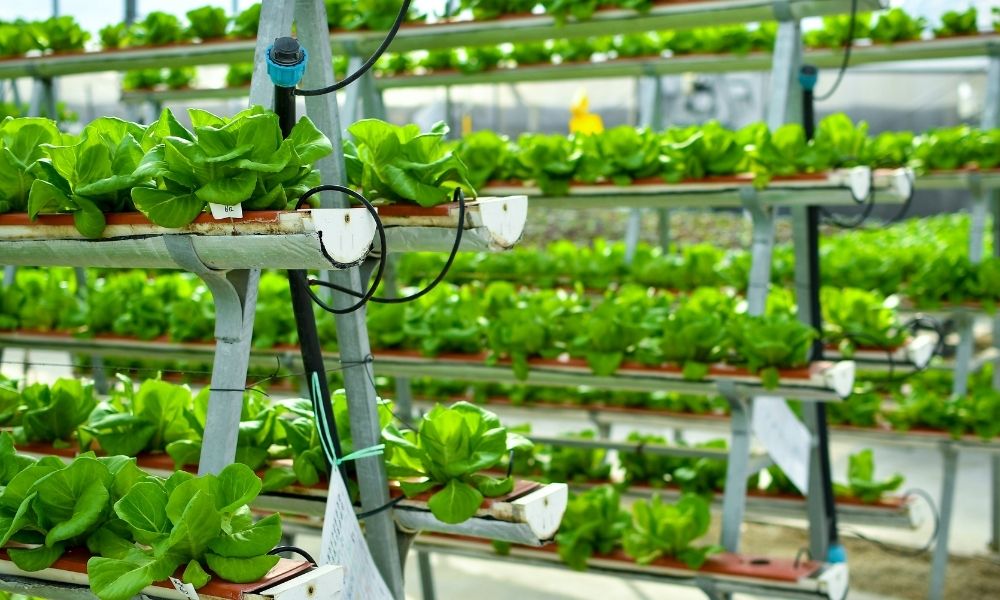Vertical Farming
Vertical Farming Vertical farming is a modern agricultural method where crops are grown in vertically stacked layers or inclined surfaces, often within controlled environments such as buildings, shipping containers, or greenhouses. It uses advanced technologies like hydroponics, aeroponics, and aquaponics to maximize crop yield in minimal space. Principles of Vertical Farming 1. Space Optimization: Utilizes vertical space to grow crops, allowing for high-density production. 2. Controlled Environment Agriculture (CEA): Regulates temperature, humidity, light, and nutrients to optimize plant growth. 3. Resource Efficiency: Minimizes water, land, and energy use through closed-loop systems. 4. Sustainable Practices: Reduces pesticide use, carbon footprint, and food miles. Techniques in Vertical Farming 1. Hydroponics: • Method: Plants grow in a nutrient-rich water solution without soil. • Benefits: Requires 90% less water than traditional farming. 2. Aeroponics: • Method: Plants are suspended in the air, and nutrient-rich mist is sprayed on the roots. • Benefits: Uses 95% less water and promotes faster growth. 3. Aquaponics: • Method: Combines fish farming (aquaculture) with plant cultivation (hydroponics). Fish waste provides nutrients for plants. • Benefits: Creates a self-sustaining ecosystem and reduces chemical inputs. 4. Soil-Based Vertical Farming: • Method: Uses organic or synthetic soil in stacked trays for plant growth. • Benefits: Suitable for larger crops requiring soil nutrients. Advantages of Vertical Farming 1. Increased Yield: • Produces up to 10 times more food per square meter than traditional farming. 2. Reduced Water Usage: • Uses up to 90% less water due to recirculating systems. 3. Climate Resilience: • Grows food year-round in any climate, unaffected by weather extremes. 4. Urban Integration: • Enables food production in urban areas, reducing transport costs and food wastage. 5. Less Land Degradation: • Minimizes deforestation and soil erosion by reducing the need for farmland. Challenges of Vertical Farming 1. High Initial Investment: Requires advanced technology and infrastructure, leading to high setup costs. 2. Energy Consumption: Controlled environments need significant energy for lighting and climate regulation. 3. Crop Limitations: Currently best suited for leafy greens, herbs, and small fruits—not large-scale staple crops. 4. Technical Expertise: Requires specialized knowledge for system maintenance and plant care. Applications of Vertical Farming 1. Urban Food Security: Provides fresh, local produce in cities, reducing reliance on rural farms. 2. Disaster-Prone Areas: Ensures consistent food supply in regions affected by climate shocks. 3. Community Initiatives: Supports community gardens and local employment in urban areas. 4. Education & Research: Offers platforms for agricultural innovation and research in sustainable practices. Government & Policy Support in India 1. National Mission on Sustainable Agriculture (NMSA): Promotes climate-resilient farming technologies, including vertical farming. 2. Agro-Processing Clusters: Provides funding for urban agriculture initiatives. 3. Subsidy Support: State-level schemes encourage adoption of hydroponics and controlled-environment agriculture. Steps to Implement Vertical Farming 1. Site Selection & Infrastructure: • Identify suitable urban or peri-urban locations (e.g., rooftops, warehouses). • Design vertical structures with hydroponic, aeroponic, or soil-based systems. 2. Technology Integration: • Install climate control, LED lighting, and automated irrigation systems. • Use smart sensors to monitor plant health and optimize resource use. 3. Crop Selection: • Prioritize fast-growing, high-value crops like leafy greens, herbs, strawberries, and tomatoes. 4. Capacity Building: • Train farmers and community members in vertical farming techniques and system maintenance. 5. Market Linkages: • Establish direct-to-consumer models (e.g., farm-to-table) or partnerships with local markets. Future of Vertical Farming in India • Urban Agriculture Expansion: Growing interest in rooftop and indoor farming in metro cities. • Agri-Entrepreneurship: Opportunities for small-scale urban farmers and tech-based startups. • Climate Adaptation: A solution for food production in water-scarce and climate-vulnerable regions.



